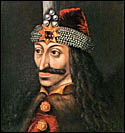 |
|
 |
| Home | Photos | Vlad Shop | Transylvania Tours |
 |
|
 |
Vlad Tepes was born in the town of Sighisoara, Romania. The house in which he was born is still standing (with a restaurant on the second floor). Sighisoara is unique in that it is the only medieval citadel in Europe still currently inhabited. Many people continue to live in structures that are 600 to 700 years old.
|
||||
 The place where Vlad was born and raised |
 |
 |
||
|
||||
Bran Castle is often referred to as "Dracula's Castle." This designation is a bit of a misnomer, for there is apparently no evidence that it was ever owned, lived in or visited by Vlad Tepes (although he may have stayed there on occasion in his travels between Tirgoviste and Brasov). The castle is definitely linked to Vlad, however, in that his grandfather, Mircea the Great, was one of its first owners. The castle also certainly represents a significant architectural and historical landmark.
|
|||||
|
 |
 |
 Hidden stairway discovered in the 1930s |
||
Photos with commentary courtesy of Sonny Degraw, http://www.draculascastle.com/index3.html
The ruins of Poenari are part of a larger complex of structures called the "Royal Court of Tirgoviste." Within this complex is a structure called "Chindia Tower," built by Vlad Tepes as a watchtower and is sometimes referred to as Vlad's "Palace." The structure was restored and given an extra story in the 19th Century. It houses an impressive collection of historical information on Vlad Tepes. Tirgoviste is significant in that when Vlad became voivode of Wallachia, he established it as his capital. There is a large bust of Vlad in the city of Tirgoviste, not far from the palace ruins.
|
||||
 |
||||
Impalement was Vlad’s preferred method of torture and execution. Impalement was one of the most gruesome ways of dying imaginable, as it was typically slow and painful. Victims included warring enemies, unfaithful noblemen, dishonest merchants and unchaste women.
|
||||
 |
||||
Vlad was ultimately killed and decapitated by unfaithful boyars; his perfumed head sent to the Ottoman Sultan as a gift, and as appeasement. The official burial place of Vlad is the Snagov Monastery, on Lake Snagov, near Bucharest. There is some mystery surrounding the tomb, however. An excavation performed in 1931 reportedly found an empty grave, while some accounts tell of the exhumation of a richly dressed decapitated body.
|
||||
 |
||||
Bram Stoker based his novel Dracula (published in 1897) upon the historical figure of Vlad Tepes. Just how much Stoker knew about the life and atrocities of Vlad Tepes is unclear, but he was certainly aware of Vlad from a reference in a history book obtained from the library of Whitby. In any event, Bram Stoker's Dracula has helped tremendously to popularize the region and to make Vlad Tepes one of the most well-known medieval figures that ever lived.
|
||||
 |
||||
|
||||
Coinage |
|
Vlad's family tree |
||
For more info on coinage: Guy Clark Ancient Coins Fitzwillian Museum |
||||
|
||||
|
Map of Romania |
 Map
of Romania |
Map of Eastern Europe |
||
|
||||
|
Elizabeth Bathory |
 Medieval illustration |
Medieval illustration of the |
||
![]()
* * * * * * * * *